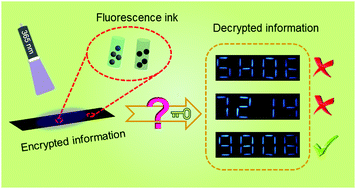Dual information encryption of carbon dots endowed with recoverable functions after interception†
Abstract
Conventional encryptions including single and multiple encryptions still have disadvantages, such as low security, complicated operation process and time consuming. Herein, a dual information encryption mechanism based on the exclusivity of the decryption process is proposed, which uses carbon dots (CDs) as fluorescent inks with two rounds of encryption and decryption to perform dual information encryption. The encryption process is easy to operate, and the decryption process can be completed in a short time (<8 s) with the correct decryption method. Importantly, this dual information encryption brings higher security, because the encrypted information cracked by an incorrect decryption method will obtain readable information. This readable information seems to be correct information, but in fact it is deluded information, which can prevent further decoding attempts. Using this dual information encryption mechanism, we designed three distinct applications including deluded information, high-density storage, and recoverable functions after being intercepted. The proposed information encryption idea may provide a new way for information encryption with more security.



 Please wait while we load your content...
Please wait while we load your content...